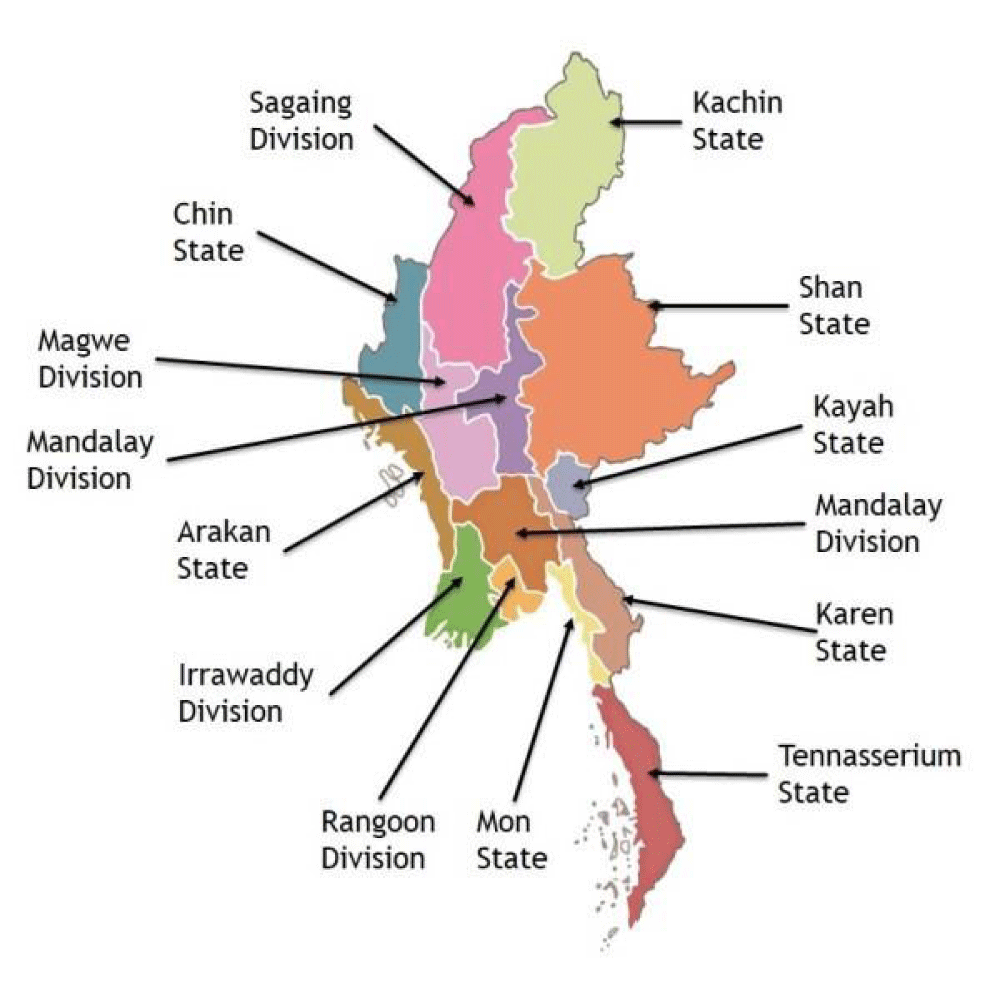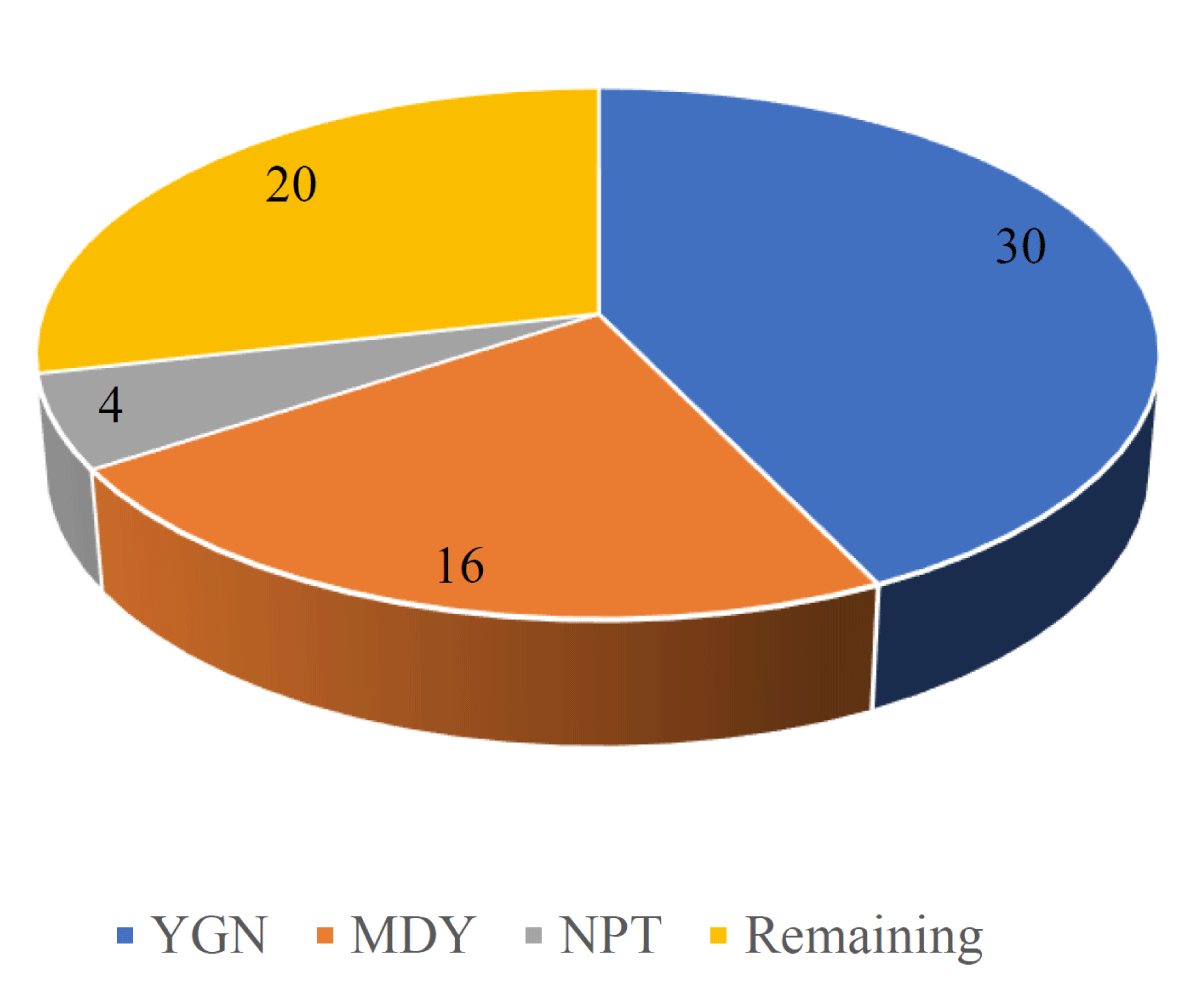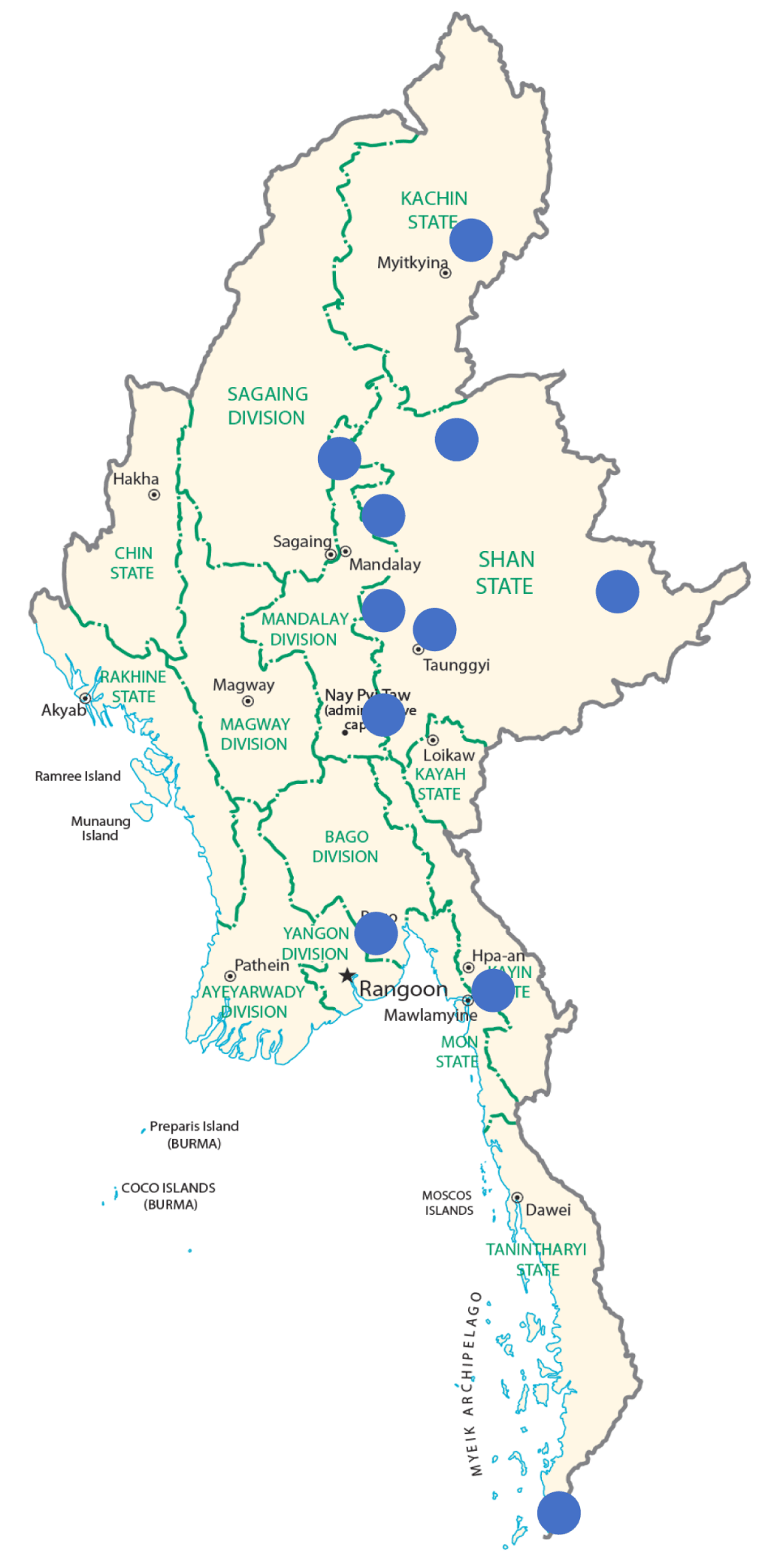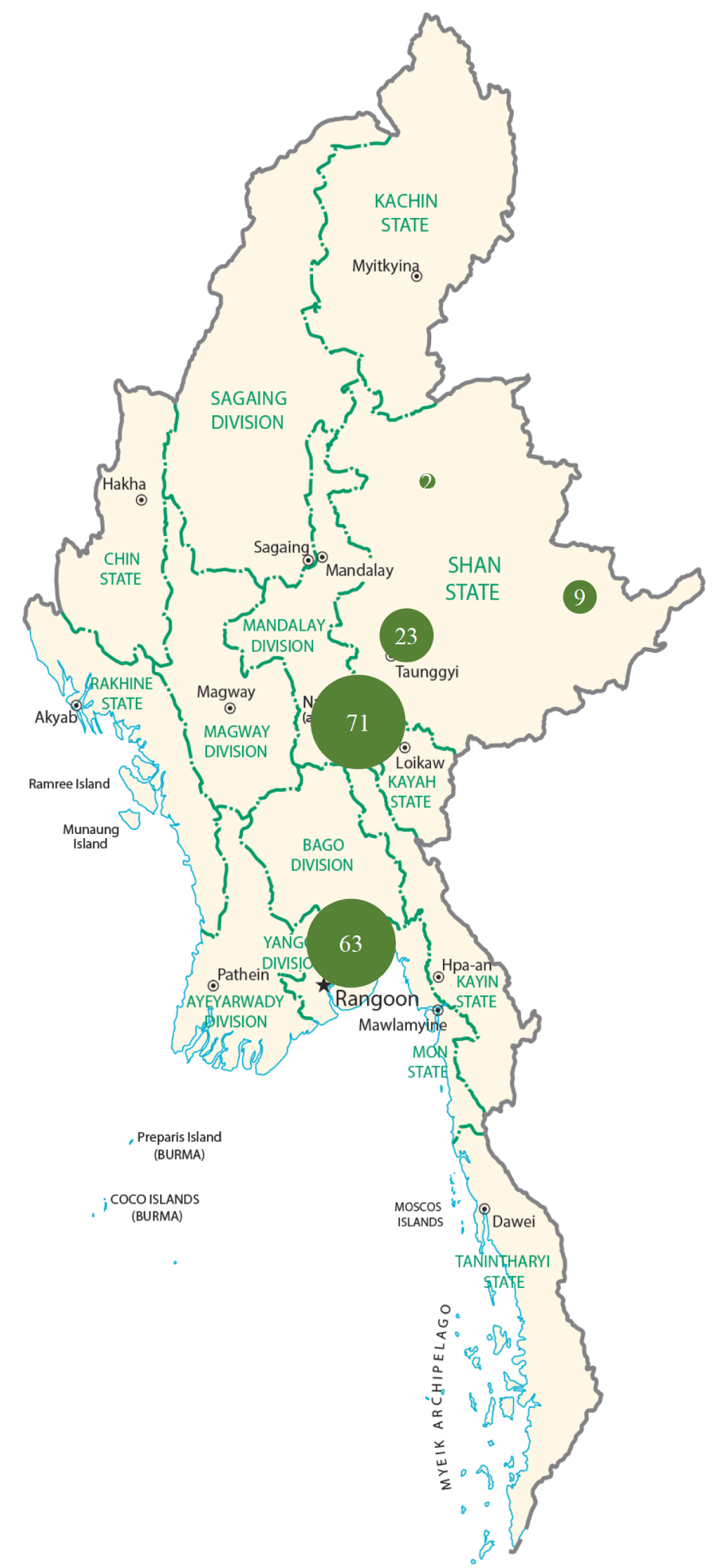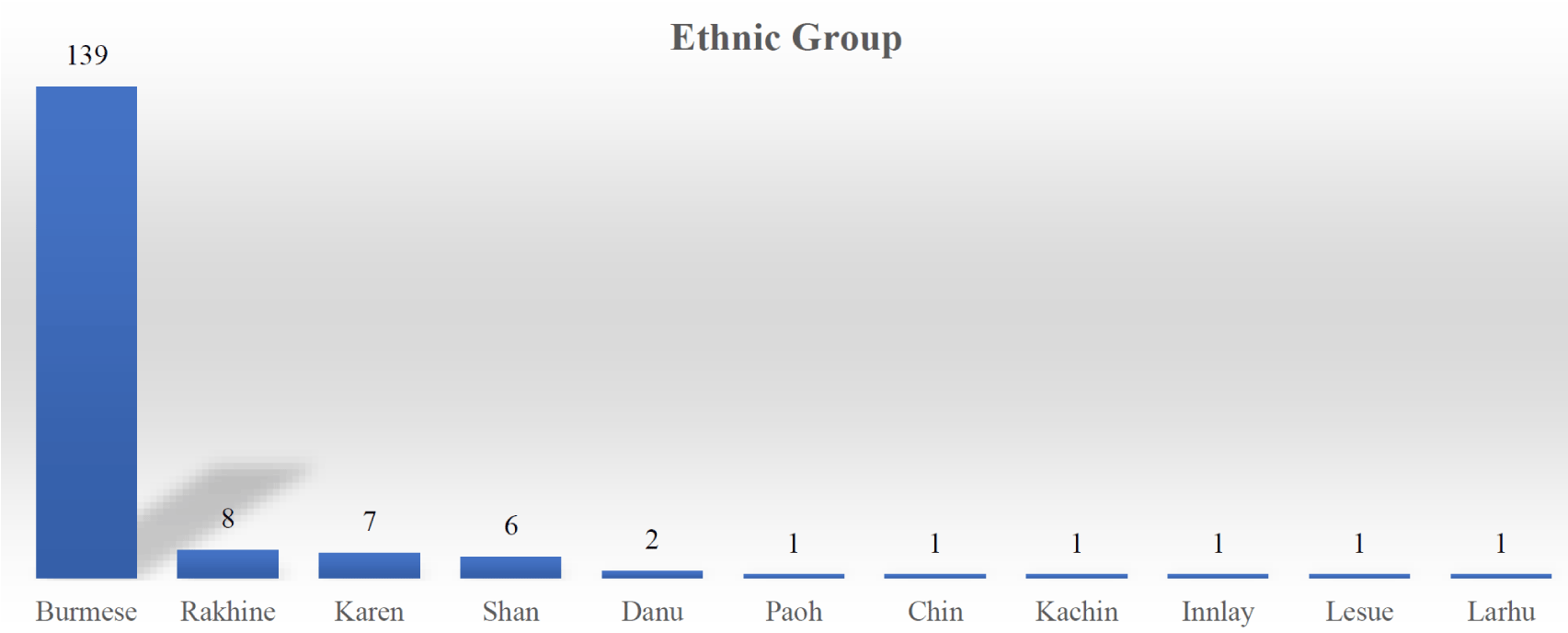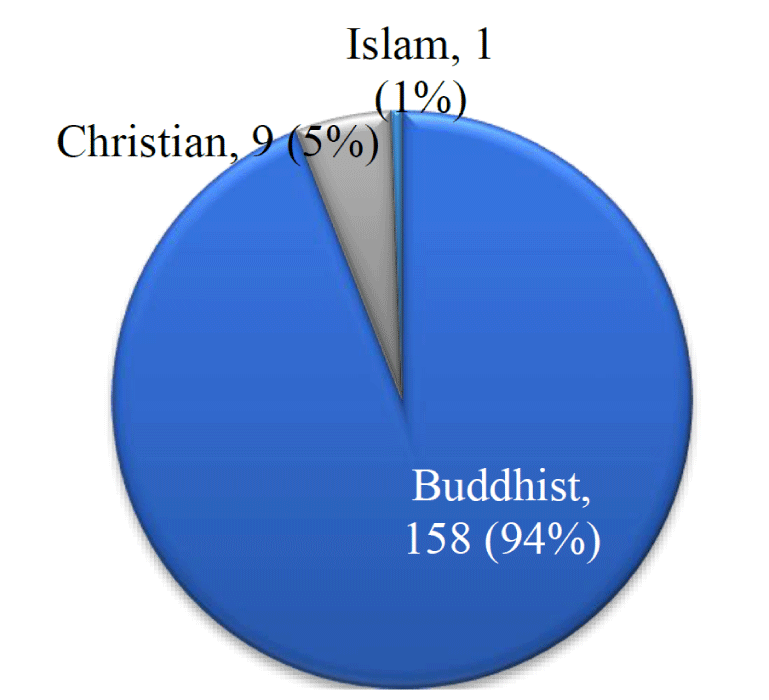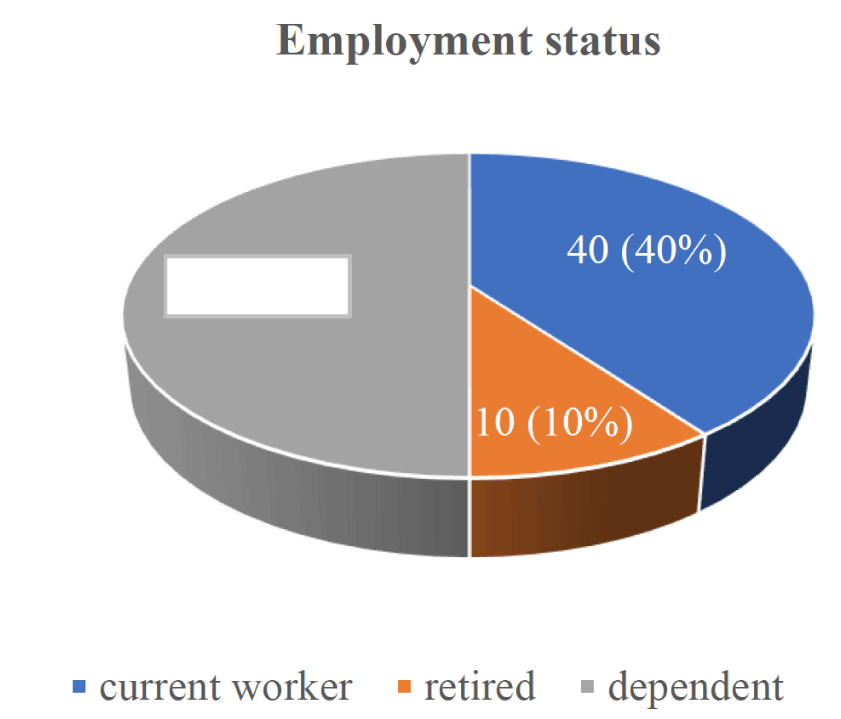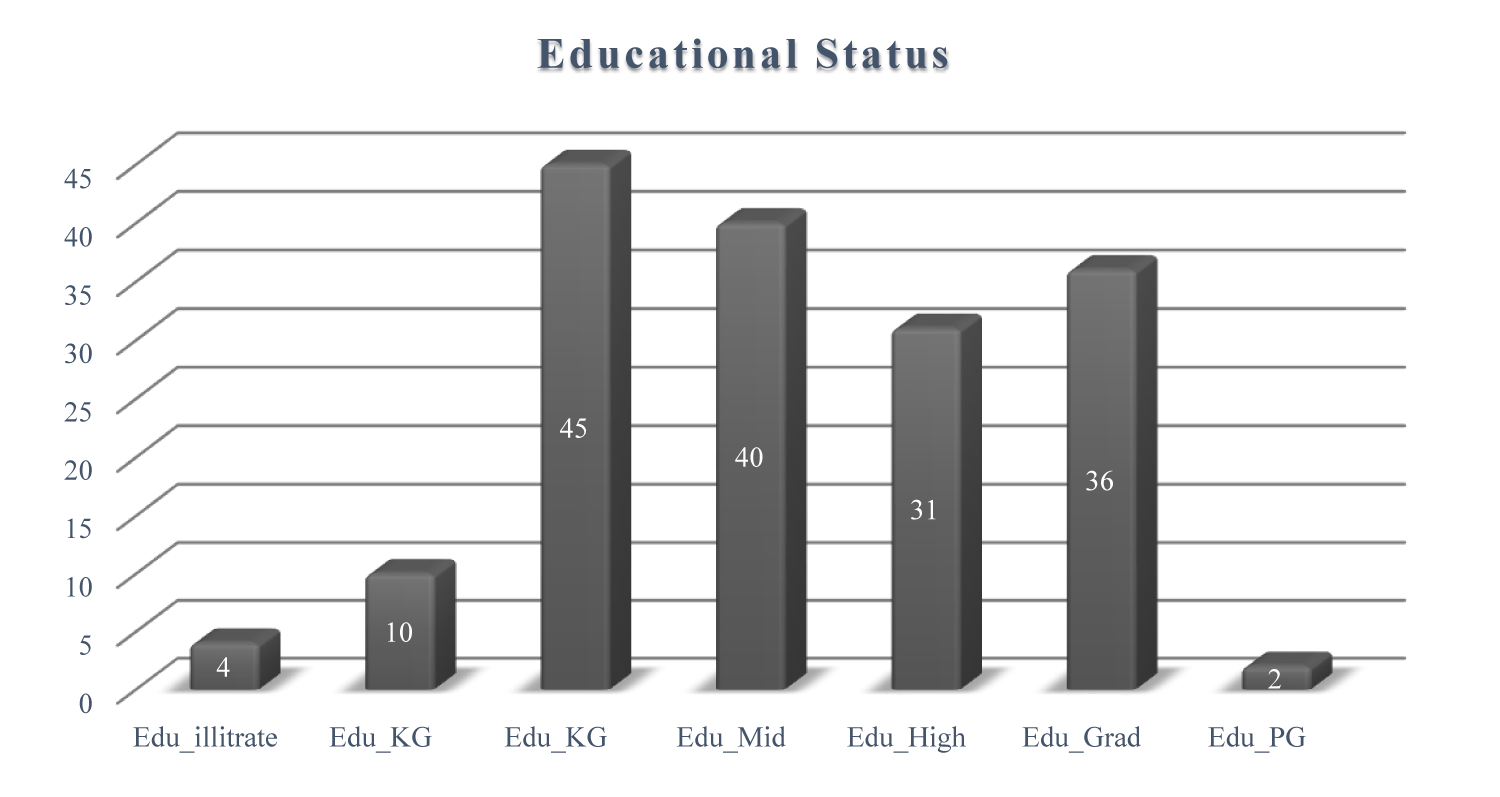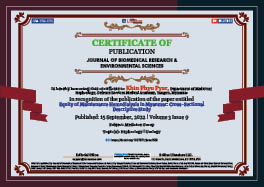Medicine Group . 2022 September 15;3(9):1045-1053. doi: 10.37871/jbres1553.
Equity of Maintenance Hemodialysis in Myanmar: Cross-Sectional Descriptive Study
Khin Phyu Pyar1,2*, Win Kyaw Shwe3, Kyaw Thu Yein Lwin4, San Lin5, Aung Zaw Htet5, Phyo Mouk Aung6, Aung Hlaing Win7, Lay Maung Maung8, Ye Min Hein8, Lynn Htet Aung8, Myo Min Thant8, Myo Maung Maung8, Moe Htun Zaw8, Sai Aik Hla8, Ye Htook Mg8, Zin Zin Aung3, Kyaw Zaw Lin9, Zar Ni Htet Aung10, Nyan Lin Maung10, Moe Zaw Myint3 and Thet Aung3
2Senior Consultant Physician/Nephrologist, No. (1) Defence Services General Hospital (1000-Bedded), Yangon, Myanmar
3Consultant Nephrologist, Department of Nephrology, No. (2) Defence Services General Hospital (1000-Bedded), Nay Pyi Taw, Myanmar
4Consultant Nephrologist, Department of Nephrology, No. (1) Defence Services General Hospital (1000-Bedded), Yangon, Myanmar
5Consultant Nephrologist, Department of Nephrology, No. (2) Defence Services General Hospital (700-Bedded), Aung Ban, Myanmar
6Consultant Physician, No. (3) Defence Services General Hospital (300-Bedded), Kyaing Ton, Myanmar
7Consultant Physician, No. (9) Defence Services General Hospital (100-Bedded), Lashio, Myanmar
8Nephrology Fellow, Department of Nephrology, Defence Services Medical Academy, Yangon, Myanmar
9Consultant Nephrologist, Department of Nephrology, No. (1) Defence Services General Hospital (700-Bedded), Pyin Oo Lwin, Myanmar
10Consultant Physician, No. (1) Defence Services General Hospital (1000-Bedded), Yangon, Myanmar
- Renal Replacement Therapy (RRT)
- Maintenance hemodialysis; Race
- Religion
- Employment
- Travel time
Abstract
Background: Maintenance hemodialysis has been the commonest Renal Replacement Therapy (RRT) in Myanmar. The equity is questionable in Myanmar, a developing country, as developed countries reported inequities of dialysis in various aspects.
Methods: A cross-sectional descriptive study was conducted in selected Hemodialysis Centers (HDC) which are under the care of government of Myanmar in August 2022. Data were collected by using standardized forms and analysis was done.
Results: A total of 168 cases from 5 HDC situated in Yangon (lower part of Myanmar), Nay Pyi Taw (central part of Myanmar), Aung Ban (Eastern part of Myanmar), Lashio (North eastern part of Myanmar) and Kyaing Ton (near Golden Triangle) were included. The age range was 21-79 years; old age was not excluded for maintenance hemodialysis. Male to female ratio was 1:1.2 revealing accessibility of both sex to maintenance hemodialysis. The proportion of ethnic groups was Burmese (139/168), Rakhine (8/168), Karen (7/168), Shan (6/168), Danu (2/168), Paoh (1/168), Chin (1/168), Kachin (1/168), inlay (1/168), Lesue (1/168) and Larhu (1/168); it was in accordance with normal ethnic distribution in Myanmar. Regarding religion, the majority were Buddhist (158/168); Nine patients were Christian. One patient was Islam. It was proportionate with percentage of population by religion in 2014 Census. Only 38 patients were graduates and four patients were illiterate; therefore, illiterates were accessible to maintenance hemodialysis. Ninety-eight percent of patients had comorbidities; and, 5% had 5 comorbid diseases revealing patients with multiple comorbid status were not left behind. Half of the patients were unemployed pointing that the jobless were not excluded for hemodialysis. Median travel time to HD center was 45 minutes (IQR 26-120 minutes). The maximum was 3 hours (180 minutes) in 3 patients. Half of the patients required 60 minutes travel time to HDC. Fifty percent of patients had booster vaccination to COVID-19. Most of the patients, over 90%, were doing their daily routine activity without assistance. Ninety-eight percent of patients were satisfied with treatments in their corresponding HDC.
Conclusion: There was no difference in age, sex, race, religion, comorbidity, employment status, underlying etiology and education in terms of accessibility to maintenance hemodialysis. Although they were dealing with long travel time of more than one hour in 50% of cases, their attitude was positive. As half of the patients had travel time of more than an hour, we need new HDC in Aung Ban. Resource allocation to renal replacement therapy should be encouraged at ministry level.
Introduction
Renal Replacement Therapy (RRT) is the only measure for saving the lives of patients with end stage renal disease. It may be maintenance hemodialysis, Chronic Ambulatory Peritoneal Dialysis (CAPD) or renal transplant. RRT as maintenance hemodialysis has been initiated in Myanmar since 1970 in Government hospital with one machine. Later, the number of HD machines and Hemodialysis Centers (HDC) increased gradually. In private sector, HD was launched in 1996.
Hemodialysis was the main RRT currently practicing in Myanmar; the number of patients on CAPD was very few less than 20. Both Hemodialysis (HD) and Hemodiafiltration (HDF) were done as RRT. Improvement in the quality of care requires a steady adaptation of treatment modalities together with equity of access to dialysis facilities. It was reported that tackling dialysis burden around the world was a global challenge faced by both rich and poor countries [1].
At present, the total number of HDC in whole country was 116. Thirty-five HDC were managed by Ministry of Health; they were distributed in 14 States and Divisions including Naypyitaw (20) and District Hospitals (15) (Figure 1). Seventy HDC were run by private sectors; the distribution was mainly in big cities- Yangon, Mandalay and Naypyitaw have 61 centers (Figure 2). Eleven HDC were under the care of Ministry of Defence. They were evenly situated; Yangon, Naypyitaw, Pyin Oo Lwin (Eastern part), Aung Ban (Eastern part), Meikhtila (Central part), MyitKyina (Northern part), Mawlamyaing (Southern part), Kyaing Ton (Eastern part), Lashio (North Eastern part), Monya (Central part) and Kawthoung (Southern part) (Figure 3). Total population in Myanmar is 55.39 millions (Myanmar Population Clock); therefore, the number of chronic kidney disease in total population is expected as 5 millions. The number of registered nephrologists (Myanmar Medical Council) is 43; doctor patient ratio was desperate. (updated 5 August 2022 from MMC). It was not solved as the report in 2017 had pointed out [2].
In Myanmar, the government covered the cost of HD (20 USD, 40% of total cost) in public HDC, but it was insufficient to meet current demand, with long waiting lists of up to 6 months at government HD centers [3].
There were reports from developed countries pointing out inequities in hemodialysis among some race and ethnic groups by location [4]. Moreover, another study in US supported that the Black and Latinx communities had lower rates of home dialysis use; and, they were not completely explained by geographic, demographic, and clinical factors [5].
The travel time to HDC was the key for compliance to treatment; it was supported by UK study. They also suggested to open new HDC if travel time was more than 30 minutes [6].
Five year follow up study done in France pointed out that adherence to treatment depended mainly on travel time even though the patients received free medical care [7]. Moreover, one report highlighted inequities in dialysis care and outcomes; and, the importance of health policy in kidney care [4]. They also reported Inequities in nephrology referral, vascular access, use of home dialysis modalities, kidney transplantation, and mortality were prominent in socially disadvantaged persons, including racial and ethnic minorities, individuals with low incomes, homeless persons, and non-US citizens bear a disproportionate burden of end-stage kidney disease. The study from New Zeeland addressed inequitable treatment practices and outcomes in end-stage kidney disease care [8].
The finding on treatment gaps in RRT was shocking; and, it was described as “the largest treatment gaps in low-income countries, particularly Asia (1.907 million people needing but not receiving RRT; conservative model) and Africa (432,000 people; conservative model)”. They also predicted that worldwide use of RRT would project to more than double to 5.439 million (3.899-7.640 million) people by 2030, with the most growth in Asia (0.968 million to a projected 2.162 million [1.571-3.014 million]) [9]. According to study on clinicians’ perspectives from Australia, geographical barriers, dislocation from homes and financial hardship were the major challenges for patients in accessing kidney replacement therapy in rural area [10].
Myanmar, being a developing country, the resources were limited. The need for government reimbursement and national health insurance to provide universal health coverage was mentioned in 2017 [3].
Therefore, the accessibility to hemodialysis treatment may vary with several factors like age, sex, race, religion, comorbidity, employment status, underlying etiology and education. The prevalence of hemodialysis might fall with longer travel time to HDC. In the COVID-19 era, the accessibility to vaccination plays an important role too. Therefore, this study aimed to access the possible factors for accessibility to maintenance hemodialysis in public HDC in Myanmar. The results would help better equity in maintenance hemodialysis in the future.
Methods
Study design and population
Study area: A cross-sectional descriptive study was conducted in August 2022 in selected public Hemodialysis Centers (HDC): Yangon (lower part of Myanmar), Nay Pyi Taw (central part of Myanmar), Aung Ban (Eastern part of Myanmar), Lashio (North eastern part of Myanmar) and Kyaing Ton (near Golden Triangle) (Figure 4). They are under the care of government of Myanmar. Informed consent was taken from both patients and their attending nephrologists and physicians. Data were collected by using standardized forms and analysis was done.
Operational definitions
Maintenance hemodialysis was defined as hemodialysis done either twice a week or three times a week for more than two months in patients with end stage renal disease. End stage renal disease was defined as patients with chronic kidney disease stage 5. Race was the type of race registered in National Registration Card. Religion was the type of religion registered in National Registration Card. Comorbidity was a presence of more or additional medical conditions or diseases like diabetes mellitus, hypertension, cardiovascular disease (ischemic heart disease, atrial fibrillation, heart failure), obesity (BMI more than 30), chronic lung disease (chronic obstructive airway disease, bronchial asthma), neurological disease (stroke, dementia), chronic liver disease (chronic liver disease with or without portal hypertension), malignancy (cancer, leukemia, lymphoma).
Occupation was defined as current worker if the patient is currently working; and unemployed/dependent if the patient is currently not working. Retired was defined if the patient retired from job and he is having monthly pension salary.
Underlying etiology was defined as the etiology causing end stage renal disease.
Education was classified as illiterate, primary education level, middle education level, high education level, graduates and post-graduates. Illiterate was defined if the patient did not attend primary education level or equivalent one like monastery education. Primary education level was defined if the patient finished primary education level. Secondary education level was defined if the patient finished secondary education level. High education level was defined if the patient finished high education level. Graduate was defined if the patient got degree from University/Institute. Post-graduate was defined if the patient got post-graduation degree from University/Institute. First booster dose vaccination was defined if the patient received total 3 dose of COVID-19 vaccine either same of different one. Second booster dose vaccination was defined if the patient received total 4 dose of COVID-19 vaccine either same of different one. Third booster dose vaccination was defined if the patient received total 5 doses of COVID-19 vaccine either same or different one.
Travel time to HD center was defined as the duration of total travel time from the patient’s residence to HDC which included the waiting time for public transport.
Satisfaction to attending HDC was categorized into excellent satisfactory, good/satisfactory, and non-satisfactory. Excellent satisfactory status was defined if the patient was extremely satisfied with treatment at HDC. Good satisfactory status was defined if the patient was satisfied with treatment at HDC. Non-satisfactory status was defined if the patient was not satisfied with treatment at HDC. They were recorded anonymously with separate voting paper.
Capability in doing daily routine activity was classified as ‘good, mild restriction, moderate restriction, severe restriction, and severe restriction requiring assistance’.
Data collection and procedure
The total number of referral cases of ESRD to nephrologists, and the total number patients on maintenance hemodialysis were recorded. Demographic characteristics (sex, age), ethnographic data (race, religion), socio-economic data (occupation, education, capability in doing daily routine activity and travel time to HDC), COVID-19 vaccination data ( name of the vaccine, number of dose) comorbidity, underlying etiology and satisfaction to treatment at HDC were collected using a standardized case report form. The data were checked by two medical officers and then, supervision, completeness, and consistency of collected data were performed by the principle investigator.
Statistical analysis
The collected data were entered into Microsoft Excel 2016 and exported to IBM SPSS Statistics for MacOS, Version 26.0 (Armonk, NY: IBM Corp) for analysis. Descriptive statistics were presented as frequency and percentages for categorical variables and mean (Standard Deviation, SD) or median (IQR) for continuous variables.
Results
Among ESRD cases referred to nephrologists, 90% of employed patients and pensioners, and 50% unemployed patients undergone maintenance hemodialysis.
A total of 169 cases from 5 HDC situated in Yangon (lower part of Myanmar), Nay Pyi Taw (central part of Myanmar), Aung Ban (Eastern part of Myanmar), Lashio (North eastern part of Myanmar) and Kyaing Ton (near Golden Triangle) were involved in this study (Figure 4).
Mean age was 49 years; the youngest was 21 years and the oldest was 79 years. Sixty-nine male and 93 female were included.
Burmese (139/168) was the main ethnic group; and, the remaining ethnic groups were Rakhine (8/168), Karen (7/168), Shan (6/168), Danu (2/168), Paoh (1/168), Chin (1/168), Kachin (1/168), inlay (1/168), Lesue (1/168) and Larhu (1/168). It was demonstrated in figure 5.
Figure 6 illustrates distribution of religious groups. The majority were Buddhist (158/168); Nine patients were Christian. One patient was Islam. The underlying etiology of ESRD was shown in table 1; hypertension (63%) and diabetes mellitus (22%) were the main culprit. Figure 7 reveals employment status. Half of the patients were unemployed/dependent. The number of pensioners was 10% (17/168). Forty percent were current workers.
| Table 1: Frequency distribution of causes of CKD (n =168). | ||
| Causes of CKD | Frequency | Percent |
| Glomerulonephritis | 11 | 6.5 |
| Obstructive uropathy | 5 | 3.0 |
| Hypertension | 106 | 63.1 |
| Diabetes mellitus | 37 | 22.0 |
| Not identified | 6 | 3.6 |
| Polycystic kidney disease | 1 | 0.6 |
| Drug induced | 2 | 1.2 |
| Total | 168 | 100.0 |
Figure 8 shows education status. Only 38 patients were graduates; and, four patients were illiterate.
Table 2 reveals associated comorbidity. Ninety-eight percent of patients had comorbidities; and, 7 cases (4.2%) of them had 5 comorbid diseases.
| Table 2: Comorbid status (n =168). | ||
| Comorbid status | Number | Percent |
| No comorbid | 4 | 2.4 |
| 1 comorbid | 104 | 61.9 |
| 2 comorbid | 43 | 25.6 |
| 3 comorbid | 8 | 4.8 |
| 4 comorbid | 2 | 1.2 |
| 5 comorbid | 7 | 4.2 |
| Total | 168 | 100 |
Median travel time to HDC was 45 minutes (IQR 26-120 minutes). The minimum time was 15 minutes; the maximum was 3 hours (180 minutes). Half of the patients required an hour travel time to HDC.
Regarding the vaccination status of COVID-19, fifty percent had first booster dose (total 3 dose of vaccine either same of different one); second booster dose (total 4 doses) was achieved in 14.3% (24/168) and third booster dose (total 5 doses) in 4 cases (2.4%). It is demonstrated in table 3.
| Table 3: COVID-19 vaccination status (n =168). | ||
| COVID-19 Vaccine Frequency | Number | Percent |
| Never vaccinated | 7 | 4.2 |
| Only one dose | 5 | 3.0 |
| Only 2 doses | 43 | 25.6 |
| 1st Booster (3 doses) | 85 | 50.6 |
| 2nd Booster (4 doses) | 24 | 14.3 |
| 3rd Booster (5 doses) | 4 | 2.4 |
| Total | 168 | 100 |
Most of the patients (154/168) were doing their daily routine activity without assistance (Figure 9). One assistance was necessary in 2.4% (6/168). Their mobility was restricted mainly due to neurological problem; cerebellar stroke, sciatica, prolapsed intervertebral disc with paraplegia, two cases of cerebrovascular accident with hemiplegia (lower limb power 3/5). One patient had pulmonary tuberculosis with general debility.
Table 4 mentions satisfactory status to HDC. Ninety-one percent of patients (153/168) were satisfied with treatments in their corresponding HDC; the remark was excellent. Good remark was given by 8.3% (14/168); and one patient was not satisfied with treatment at HDC.
Discussion
There are 14 States and Divisions in Myanmar. Seven States occupy hilly regions where they are less populated: Shan State, Kachin State, Chin State, Rakhine State, Kayah State, Kayin State and Mon State. Seven Divisions are non-hilly areas; thus, they are densely populated: Yangon Division, Naypyitaw Division, Mandalay Division, Sagaing Division, Bago Division, Magway Division and Irrawaddy Division. Regarding the distribution of HDC under Ministry of Health, 35 in number, they were evenly distributed in each State/Division and District Hospitals. The number of hemodialysis machine were larger in those HDC situated in densely populated region. However, in private HDC, the distribution was mainly in big congested cities; HDC in Yangon, Mandalay and Naypyitaw occupied 90% of them (61/70). It was in accordance with population density as Yangon, commercial capital of Myanmar; Mandalay, second business capital of Myanmar; and, Naypyitaw, Central Government Administration capital of Myanmar are very congested. It was the same in 2017, the number of HDC in whole country was 52 (both private and government); Yangon had 30 HDC and the Districts had 20 HDC.
The HDC were under the care of Ministry of Defence were evenly placed; Yangon, Naypyitaw, Pyin Oo Lwin (Eastern part of Myanmar), Aung Ban (Eastern part of Myanmar), Meikhtila (Central part of Myanmar), MyitKyina (Northern part of Myanmar), Mawlamyaing (Southern part of Myanmar), Kyaington (Eastern part of Myanmar close to Golden Triangle), Lashio (North Eastern part of Myanmar), Monya (Central part of Myanmar) and Kawthoung (Southern part of Myanmar) (Figure 2). Nonetheless, there was no HDC in the western bank of Irrawaddy River which was relatively less populated. Therefore, new HDC are required in west bank.
The total number of HDC in whole country was 116 at present; the number was more than twice compared to 2017. Current total population in Myanmar is 55.39 milliion (Myanmar Population Clock); and, it is 53.4 million in 2017. Therefore, the extension rate of the number of HDC was fairly good; it was in accordance with population growth.
The number of registered nephrologists (Myanmar Medical Council) is 43 (updated 5 August 2022 from MMC). Therefore, it is clear that there is shortage of nephrologists; we need to recruit man power.
A total of 168 cases from 5 HDC situated in Yangon (lower part of Myanmar), Nay Pyi Taw (central part of Myanmar), Aung Ban (Eastern part of Myanmar), Lashio (North eastern part of Myanmar) and Kyaing Ton (near Golden Triangle) were included. Mean age was 49 years; the range was 21-79 years showing no discrimination in terms of patients’ age. Male to female ratio was 1:1.2. And, the ratio generally reflected that of normal population in Myanmar; equal accessibility to maintenance hemodialysis.
The reports from United States mentioned the disparity in access to hemodialysis was noticeable in non-US citizens and some religious group. Moreover, another study in US confirmed that the Black and Latinx communities had lower rates of home dialysis use; and, they were not completely explained by geographic, demographic, and clinical factors [5].
In this study the proportion of ethnic groups was Burmese (139/168), Rakhine (8/168), Karen (7/168), Shan (6/168), Danu (2/168), Paoh (1/168), Chin (1/168), Kachin (1/168), inlay (1/168), Lesue (1/168) and Larhu (1/168); it was in accordance with ethnic distribution in Myanmar. Regarding religion, the majority were Buddhist (158/168) in this study; it again reflected the main religious group in Myanmar. Nine patients were Christian and one patient was Islam; no discrimination in religion. The findings were proportionate with percentage of population by religion in 2014 Census. Only 38 patients were graduates; four patients were illiterate. Ninety-eight percent of patients had comorbidities; and, 5% had 5 comorbid diseases. Half of the patients were unemployed. The study from Australia identified the importance of financial hardships though HDC were supported by government [10]. Socio-economic equity was emphasized in findings from Indonesia study; higher frequency of hemodialysis use wes directly affected by higher family income, distance < 20 km, working in informal sector, beneficiary of government subsidy, longer duration of hemodialysis, severe condition of illness, and living in urban area [11]. Study from both France and UK highlighted the importance of travel time to HDC [6,7]. In this study, the median travel time to HD center was 45 minutes (IQR 26-120 minutes). The minimum travel time was 15 minutes; the maximum was 3 hours (180 minutes). Those with 3 hours travel time were living in hilly regions with hard-to-reach areas. The travelling distance from Loikaw to Aung Ban is 160 km and travel time is 3 hours. The travelling distance from Pin Long to Aung Ban is 75 km and travel time is nearly 2 hours. The waiting time for public bus is variable 20-30 minutes unlike the transport system in developed countries.
The researchers from Australia found that geographical barriers were important in long term adherence [10]. Half of the patients required an hour travel time to HDC. The findings from United Kingdom pointed out that the adherence to treatment, hemodialysis, was inversely proportionate with travel time. They also recommended to build a new HDC if travel time was more than 45 minutes. Therefore, we need more HDC and human resources. Reallocation of man, materials and money to kidney health by modification of health policy should be done; same suggestions by other study [4]. The role of policies was the main key player in achieving equity in dialysis care and outcomes.
Tackling dialysis burden around the world was a global challenge [1].
Ninety-eight percent of patients were satisfied with treatments in their corresponding HDC. And, their own comments on doing daily activity were fairly good. They revealed the nature of Burmese. They were very patient; and, they were positive thinkers though they were not rich and dealing with long travel time to HDC.
In view of vaccination status to COVID-19, most of them had booster dose. They were in the priority list for booster regimen in view of poor immunity. They were lucky as only half of total population received two doses of COVID-19 vaccine.
Limitation of the Study
Although there are 116 HDC in Myanmar, only 5 centers are included. Both patients and attending nephrologists had to give informed consent for this study. The analysis would be better if larger number of patients as well as number of HDC were included. Moreover, only government funded centre were included in the study as the doctors from private HDC did not give informed consent. The employment and education status may be different from that of private center. It is clear that the cost of one session of HD in the private center is expensive- USD 50. And, the government servant cannot afford to do HD in private center. It is clear that the equity to HD in government funded center may be different from that of private HDC in view of socioeconomic status. Female preponderance in this study is by chance; no particular reason. Though the travelling distance is constant, the travel time is variable. The waiting time for public transport (bus) is variable 20-30 minutes unlike the transport system in developed countries. Therefore, equity of dialysis depends also on smoothness of transport system.
Conclusions
In terms of age, sex, race, religion, comorbidity, occupation status, underlying etiology and education status, the patients were equally accessible to maintenance hemodialysis. Although they were dealing with long driving time, they were satisfied. As half of the patients had driving time of more than an hour, we need new HDC particularly in Southern Shan State. Accessibility to booster dose COVID-19 vaccination is good; and, it should also be expanded. It is urgently required to train more nephrologists as the number of nephrologists was less than fifty in whole country. Resource allocation to renal replacement therapy should be encouraged at higher authoritative level. Not only the health sector but also the remaining sectors like transport and communication, and local production of pharmaceuticals and dialyzers should be strengthened to get more equity in maintenance hemodialysis; saving more lives of ESRD.
Recommendations
To improve equity of hemodialysis, the followings are suggested. New HDC is required to increase accessibility if travel time is more than 60 minutes; definately in Southern Shan State according to this study. Training for new nephrologists is urgently required to improve doctor patient ratio and quality of care; availability. Sustainability of COVID-19 booster vaccination should be maintained. Resource allocation to maintenance hemodialysis should be considered at ministerial level. Transport and communication services should be promoted. Dialyzers and hemodialysis solutions should be produced locally to cut down the costs of hemodialysis; affordability. Research on patients’ perspectives are required.
Acknowledgment
We are thankful to Professor Ko Ko Lwin, Professor Kyaw Zay Ya, Directorate of Medical Services; Professor Myint Zaw (Yangon HDC), Professor Aung Myat Kyaw (NayPyi Taw HDC),Professor Myo Thant, Professor Saw Yan Naing & Dr Min Soe Oo for their administrative support. We are also grateful to all patients and health care personnel included in this study.
Ethical consideration
The data collection using standardized case report forms was approved by Hospital Ethics Review Committee of Defence Services General Hospital, Mingaladon. Privacy and confidentiality of information were maintained throughout the study process.
Conflict of interest
There is no COI.
Funding
No funding was obtained.
References
- Li PK, Chan GC, Chen J, Chen HC, Cheng YL, Fan SL, He JC, Hu W, Lim WH, Pei Y, Teo BW, Zhang P, Yu X, Liu ZH. Tackling Dialysis Burden around the World: A Global Challenge. Kidney Dis (Basel). 2021 May;7(3):167-175. doi: 10.1159/000515541. Epub 2021 Apr 29. PMID: 34179112; PMCID: PMC8215964.
- Masuda T. The "Dialysis Situation in Asian Countries" Symposium: Providing New Insights to Improve Dialysis in the Region. Blood Purif. 2017;44 Suppl 1:3-18. doi: 10.1159/000479576. Epub 2017 Sep 5. PMID: 28869951.
- Hyodo T, Fukagawa M, Hirawa N, Isaka Y, Nakamoto H, Van Bui P. Present status of renal replacement therapy in Asian countries as of 2017: Vietnam, Myanmar, and Cambodia. Ren Replace Ther. 2020 Dec 14;6(1):65. doi:10.1186/s41100-020-00312-w.
- Crews DC, Novick TK. Achieving equity in dialysis care and outcomes: The role of policies. Semin Dial. 2020 Jan;33(1):43-51. doi: 10.1111/sdi.12847. Epub 2020 Jan 3. PMID: 31899828.
- Rizzolo K, Cervantes L, Shen JI. Racial and Ethnic Disparities in Home Dialysis Use in the United States: Barriers and Solutions. J Am Soc Nephrol. 2022 Jul;33(7):1258-1261. doi: 10.1681/ASN.2022030288. Epub 2022 Apr 19. PMID: 35440500; PMCID: PMC9257804.
- White P, James V, Ansell D, Lodhi V, Donovan KL. Equity of access to dialysis facilities in Wales. QJM. 2006 Jul;99(7):445-52. doi: 10.1093/qjmed/hcl054. Epub 2006 May 8. PMID: 16682437.
- Richard JB, Aldigier JC, Le Mignot L, Glaudet F, Ben Said M, Landais P. Equity of accessibility to dialysis facilities. Stud Health Technol Inform. 2009;150:777-81. PMID: 19745417.
- Huria T, Palmer S, Beckert L, Williman J, Pitama S. Inequity in dialysis related practices and outcomes in Aotearoa/New Zealand: a Kaupapa Māori analysis. Int J Equity Health. 2018 Feb 20;17(1):27. doi: 10.1186/s12939-018-0737-9. PMID: 29458366; PMCID: PMC5819180.
- Liyanage T, Ninomiya T, Jha V, Neal B, Patrice HM, Okpechi I, Zhao MH, Lv J, Garg AX, Knight J, Rodgers A, Gallagher M, Kotwal S, Cass A, Perkovic V. Worldwide access to treatment for end-stage kidney disease: a systematic review. Lancet. 2015 May 16;385(9981):1975-82. doi: 10.1016/S0140-6736(14)61601-9. Epub 2015 Mar 13. PMID: 25777665.
- Scholes-Robertson NJ, Gutman T, Howell M, Craig J, Chalmers R, Dwyer KM, Jose M, Roberts I, Tong A. Clinicians' perspectives on equity of access to dialysis and kidney transplantation for rural people in Australia: a semistructured interview study. BMJ Open. 2022 Feb 17;12(2):e052315. doi: 10.1136/bmjopen-2021-052315. PMID: 35177446; PMCID: PMC8860044.
- Ardian K, Sulaeman ES, Suryono A. Social economic equity in the utilization of hemodialysis among patients with chronic renal failure under national health insurance plan at Dr. Moewardi Hospital, Surakarta. J Health Policy Manag. 2017;2(1):28-41.
Content Alerts
SignUp to our
Content alerts.
 This work is licensed under a Creative Commons Attribution 4.0 International License.
This work is licensed under a Creative Commons Attribution 4.0 International License.





